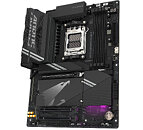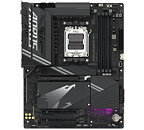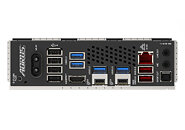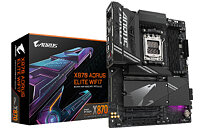- Joined
- Oct 9, 2007
- Messages
- 47,449 (7.50/day)
- Location
- Hyderabad, India
| System Name | RBMK-1000 |
|---|---|
| Processor | AMD Ryzen 7 5700G |
| Motherboard | ASUS ROG Strix B450-E Gaming |
| Cooling | DeepCool Gammax L240 V2 |
| Memory | 2x 8GB G.Skill Sniper X |
| Video Card(s) | Palit GeForce RTX 2080 SUPER GameRock |
| Storage | Western Digital Black NVMe 512GB |
| Display(s) | BenQ 1440p 60 Hz 27-inch |
| Case | Corsair Carbide 100R |
| Audio Device(s) | ASUS SupremeFX S1220A |
| Power Supply | Cooler Master MWE Gold 650W |
| Mouse | ASUS ROG Strix Impact |
| Keyboard | Gamdias Hermes E2 |
| Software | Windows 11 Pro |
GIGABYTE just released its second AMD 800-series chipset motherboard following last week's debut of the X870E AORUS Master, the more affordable X870 AORUS Elite WIFI7. This board is based on the slightly more affordable AMD X870 (non-E) chipset, which offers connectivity nearly identical to that of the previous-generation AMD B650E, but with the addition of USB4. The board is built in the ATX form-factor, and features a 6-layer PCB. It draws power from a combination of 24-pin ATX and two 8-pin EPS power connectors. The CPU VRM solution consists of a 16+2+2 phase setup, with the vCore side of it being 8-phase with phase doubling. The Socket AM5 is wired to four DDR5 DIMM slots for up to 256 GB of memory.
Expansion slots include a PCI-Express 5.0 x16 wired to the CPU, a PCI-Express 4.0 x16 (electrical Gen 4 x4), and a third PCI-Express 3.0 x16 (electrical Gen 3 x2). The main Gen 5 x16 PEG slot gets a quick-release lever. You press a button, and it ejects the graphics card. Storage connectivity includes three M.2 Gen 5 x4 slots, two of these are wired to the CPU's dedicated Gen 5 x4 NVMe lanes, while the third slot subtracts 8 lanes from the Gen 5 x16 PEG slot. There is a fourth M.2 slot, which is Gen 4 x4, and wired to the X870 FCH. All four slots get heatsinks. Four SATA 6 Gbps ports make for the rest of the storage connectivity.




Networking options, as the name of this board suggests, includes a Wi-Fi 7 WLAN card that's either a MediaTek MT7925, or a Realtek RTL8922AE, depending on the PCB revision. Besides Wi-Fi 7, both WLAN solutions put out Bluetooth 5.4. The wired networking side of things see a 2.5 GbE interface driven by a Realtek controller. USB connectivity includes two 40 Gbps USB4 ports that each include DisplayPort passthrough, a 20 Gbps USB 3.2 Gen 2x2 via a header, two 10 Gbps USB 3.2 Gen 2 type-A, four 5 Gbps USB 3.2 Gen 1, and two additional 5 Gbps USB 3.2 Gen 1 ports by header.
The onboard audio solution features a premium Realtek ALC1220 HD audio CODEC with 120 dB SNR, with ground-layer isolation, and audio-grade capacitors. There are no additional AMPs over the CODEC, but GIGABYTE tuned the solution to automatically support high-impedance headphones. There are many DIY-friendly features on offer, including a POST code read-out, LEDs that indicate a point of failure, SMD power and reset buttons, USB BIOS Flashback, PCIe x16 ejection mechanism, a quick-connect Wi-Fi antenna module, a tool-free M.2 SSD mounting mechanism, and three addressable RGB 2.0 headers. The company didn't reveal pricing.
View at TechPowerUp Main Site
Expansion slots include a PCI-Express 5.0 x16 wired to the CPU, a PCI-Express 4.0 x16 (electrical Gen 4 x4), and a third PCI-Express 3.0 x16 (electrical Gen 3 x2). The main Gen 5 x16 PEG slot gets a quick-release lever. You press a button, and it ejects the graphics card. Storage connectivity includes three M.2 Gen 5 x4 slots, two of these are wired to the CPU's dedicated Gen 5 x4 NVMe lanes, while the third slot subtracts 8 lanes from the Gen 5 x16 PEG slot. There is a fourth M.2 slot, which is Gen 4 x4, and wired to the X870 FCH. All four slots get heatsinks. Four SATA 6 Gbps ports make for the rest of the storage connectivity.




Networking options, as the name of this board suggests, includes a Wi-Fi 7 WLAN card that's either a MediaTek MT7925, or a Realtek RTL8922AE, depending on the PCB revision. Besides Wi-Fi 7, both WLAN solutions put out Bluetooth 5.4. The wired networking side of things see a 2.5 GbE interface driven by a Realtek controller. USB connectivity includes two 40 Gbps USB4 ports that each include DisplayPort passthrough, a 20 Gbps USB 3.2 Gen 2x2 via a header, two 10 Gbps USB 3.2 Gen 2 type-A, four 5 Gbps USB 3.2 Gen 1, and two additional 5 Gbps USB 3.2 Gen 1 ports by header.
The onboard audio solution features a premium Realtek ALC1220 HD audio CODEC with 120 dB SNR, with ground-layer isolation, and audio-grade capacitors. There are no additional AMPs over the CODEC, but GIGABYTE tuned the solution to automatically support high-impedance headphones. There are many DIY-friendly features on offer, including a POST code read-out, LEDs that indicate a point of failure, SMD power and reset buttons, USB BIOS Flashback, PCIe x16 ejection mechanism, a quick-connect Wi-Fi antenna module, a tool-free M.2 SSD mounting mechanism, and three addressable RGB 2.0 headers. The company didn't reveal pricing.
View at TechPowerUp Main Site







 Unless you actually need USB4, you are better off with the B650E Aorus Master or the X670E Aorus Xtreme that offer four Gen5 x4 M.2 slots connected to the CPU.
Unless you actually need USB4, you are better off with the B650E Aorus Master or the X670E Aorus Xtreme that offer four Gen5 x4 M.2 slots connected to the CPU.
